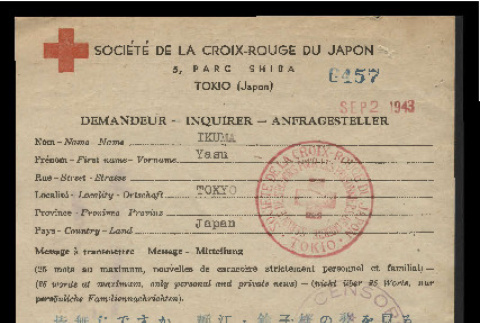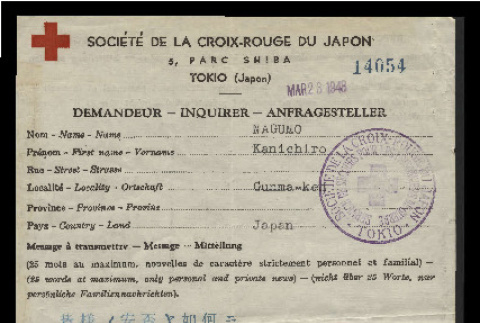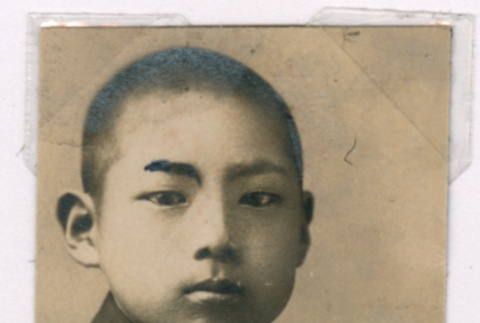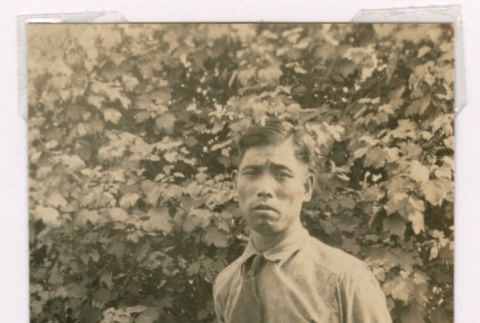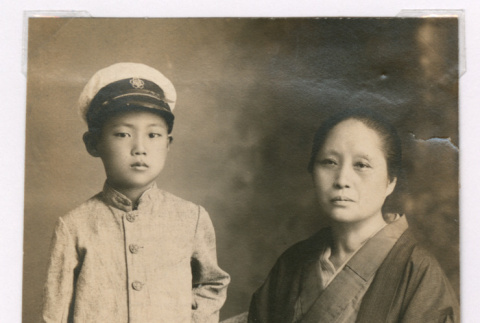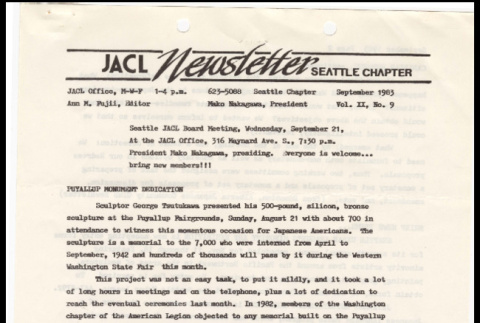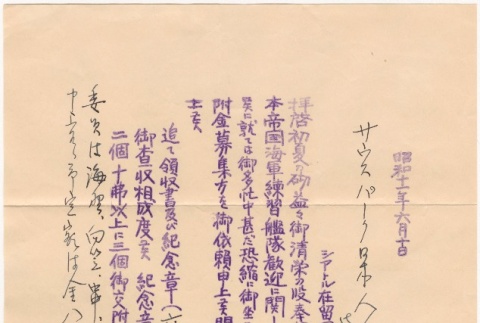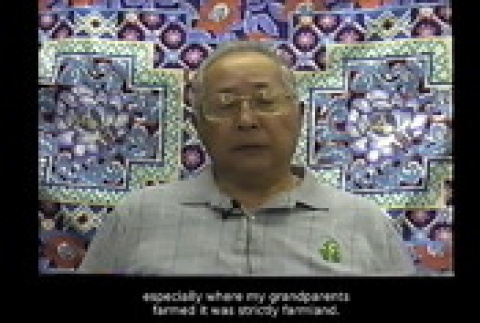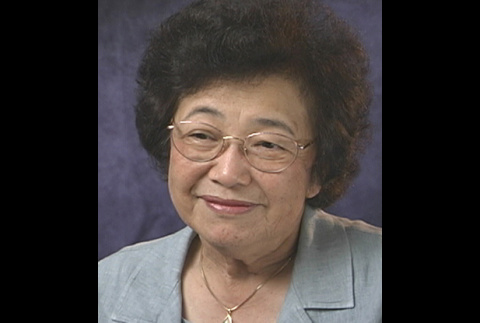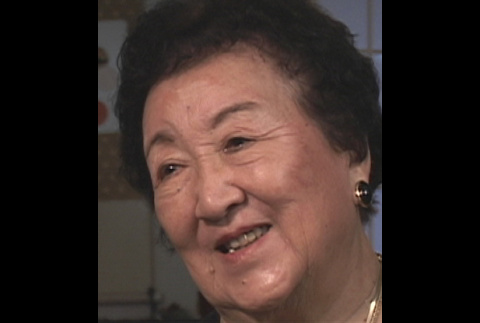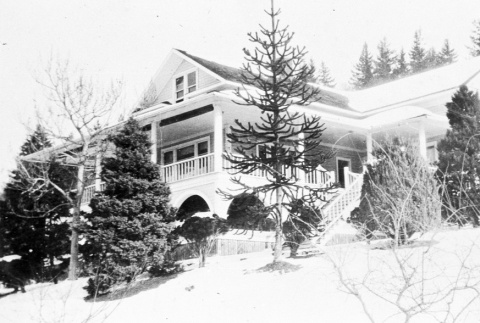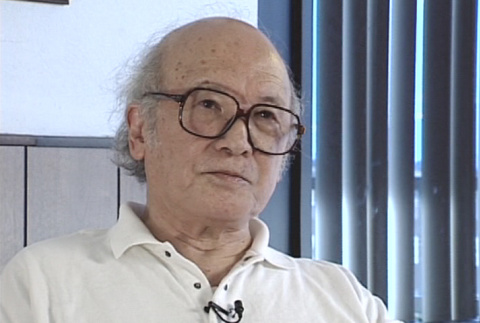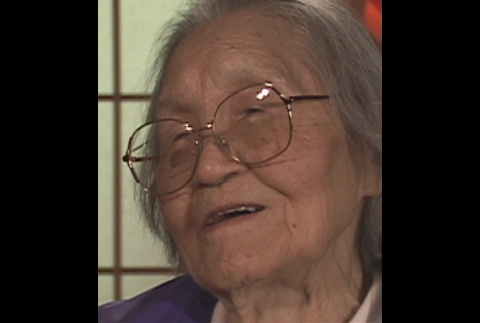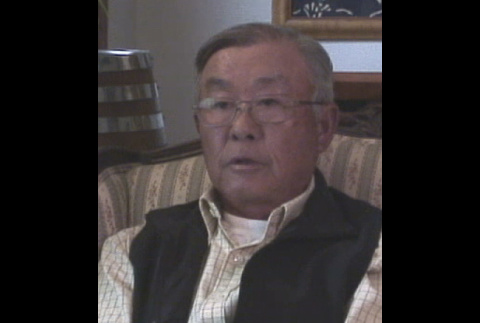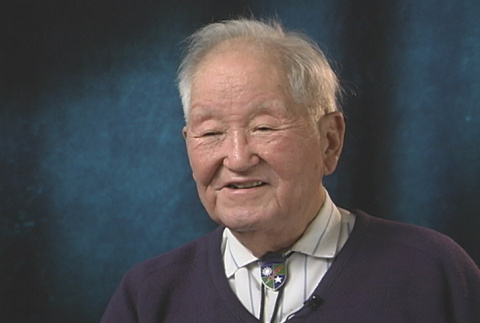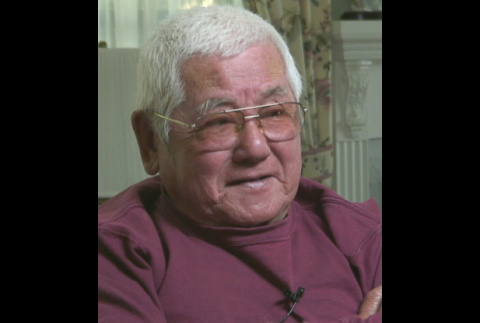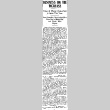4981 items
4981 items

doc
Letter from Yasu Ikuma to Shoji Nagumo, September 2, 1943 (ddr-csujad-55-892)
Letter from Yasu Ikuma in Tokyo, Japan to Shoji Nagumo in Los Angeles, California. It was sent via the Red Cross and forwarded to the Heart Mountain incarceration camp where Shoji Nagumo was incarcerated. See this object in the California State Universities Japanese American Digitization project site: sac_jaac_0894

doc
Letter from Kan'ichiro Nagumo to Shoji Nagumo, March 23, 1943 (ddr-csujad-55-890)
A message sent via the Red Cross from Kanichiro Nagumo in Gunma-ken, Japan, to Shoji Nagumo in Los Angeles, California, and forwarded to the Heart Mountain incarceraton. For English translation, see: sac_jaac_0893. See this object in the California State Universities Japanese American Digitization project site: sac_jaac_0892

img
Takeo Isoshima (ddr-densho-477-18)
Portrait of Takeo Isoshima in a school uniform. The caption on the photo is "Takeo" in blue ink. The caption below the photo is "School Boy Takeo" in black ink. The caption at the top of the album page is "TAKEO'S EDUCATION: *Graduated from Kansai High School in Okayama, Japan *Wilson Business College (bookkeeping) Seattle, WA …

img
Fusata Isoshima (ddr-densho-477-13)
Photograph of a Fusata Isoshima standing in front of a tall bush. Caption below the photo is "Takeo's Father Fusata (1921)" written in black ink. Caption on bottom of page is "Takeo's Siblings: Sister Yukiko 1913 St. Marie, Idaho Takeo 1915 St. Marie, Idaho Brother Hiroo 1918 Okayama, Japan Sister Chizu 1925 White Fish, Montana Sister …
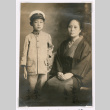
img
Portrait of Takeo Isoshima and Waki Makio (ddr-densho-477-12)
Portrait of Takeo Isoshima (left) with his grandmother Waki Makio (right). Caption below the photo is "Takeo his Grandmother Waki Makio" written in black ink. Caption on bottom of page is "Takeo's Siblings: Sister Yukiko 1913 St. Marie, Idaho Takeo 1915 St. Marie, Idaho Brother Hiroo 1918 Okayama, Japan Sister Chizu 1925 White Fish, Montana Sister …

img
Japanese American family prior to mass removal (ddr-densho-151-86)
Original caption: Mountain View, California. This ranch house, seen across a strawberry bed, is typical in many California rural sections where residents of Japanese ancestry engaged in truck gardening. This was the home of eight children who were born in this country. The parents were born in Japan. This family, and other evacuees, will be housed …
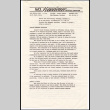
doc
Seattle Chapter, JACL Reporter, Vol. XX, No. 9, September 1983 (ddr-sjacl-1-325)
Newsletter covering the following topics: Nice article on the Puyallup Memorial Ceremony. Gov Spellman, a big supporter of the Monument and Redress, ?Every week I receive letters asking if I remember Pearl Harbor,?All these letters reflect a common confusion, confusing the was between out country and Japan with the national deprivation of civil rights. The internment …
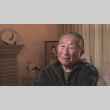
vh
Takeshi Minato Interview (ddr-manz-1-57)
Nisei male. Born July 13, 1922, in Park City, Utah. Family moved several times prior to World War II, and was living in Terminal Island, California, when Japan bombed Pearl Harbor on December 7, 1941. Removed to the Manzanar concentration camp, California, during the war. After the war, lived and worked in Chicago, Illinois, and Seabrook, …
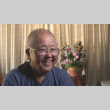
vh
Yo Shibuya Interview (ddr-manz-1-98)
Nisei male. Born August 23, 1927, in Los Angeles, California. Went to Japan for a time as a child with family before returning to California. During World War II, removed to the Manzanar concentration camp, California. While in camp, learned the saxophone and played with the Jive Bombers band. After leaving camp, attended college and began …
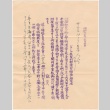
Collection
Kinuta Uno Collection (ddr-densho-324)
The Kinuta Uno Collection consists of letters and documents regarding the Uno Family's life in Seattle, Washington pre-World War II through their removal and life in Pinedale Assembly Center, Tule Lake and Minidoka concentration camp. Pre-war topics include: family business dealings and Kinuta Uno's work with the Northwest American Japanese Association, Seattle Zairyudobo, and the Consulate …
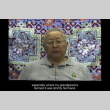
Collection
CSU Northridge Japanese Americans in the San Fernando Valley Oral History Project Collection (ddr-csujad-31)
The Japanese Americans in the San Fernando Valley Oral History Project documents the lives of Japanese Americans who lived, or are currently living, in the San Fernando Valley. The participants are multi-generational, with many who experienced firsthand internment and prejudice during World War II. The narrators also shared stories of farming, family emigration from Japan, and …

Narrator Marion Tsutakawa Kanemoto
Nisei female. Born December 30, 1927, in Seattle, Washington. Lived in Japan for fifteen months as a child, before returning to Seattle to attend junior high school. After the bombing of Pearl Harbor, father was picked up by the FBI and taken to the Department of Justice camp at Missoula, Montana. Removed to the Puyallup Assembly …

Narrator Yoneko Dozono
Nisei female. Born February 4, 1915, in Portland, Oregon. Grew up in Portland before being sent to be educated in Japan at age sixteen. Married and had children in Japan, working for the military government after World War II. Returned to Portland in the 1950s with family.

img
Summer home (ddr-densho-9-8)
This is the summer home of Masajiro Furuya, a successful merchant and banker in the Pacific Northwest. Masajiro Furuya was born in Yamanishi Prefecture, Japan, in 1862 and made his fortune in Washington State as a banker, merchant, and labor contractor. Furuya, a tailor by trade, immigrated to Seattle in 1890 and eventually opened his own …
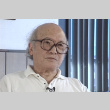
vh
Minoru Kiyota Interview (ddr-densho-1000-36)
Kibei male, born October 12, 1923, in Seattle, Washington. Raised primarily in San Francisco, California, spending four years in Hiratsuka, Japan. Was incarcerated with his family at Topaz concentration camp, Utah. Refused to sign the so-called "loyalty questionnaire," and as a consequence was moved to Tule Lake Segregation Center, California. In Tule, he renounced his U.S. …

Narrator Tom Akashi
Nisei male. Born June 7, 1929, in Merced, California. Grew up in Mount Eden, California, and was removed to the Tanforan Assembly Center, California, after the bombing of Pearl Harbor. Incarcerated at the Topaz concentration camp in Utah, then moved to Tule Lake concentration camp after family volunteered to move to Japan. While at Tule Lake, …

Narrator Tsuchino Forrester
Shin-Issei female. Born March 30, 1931 in Kasuga, Fukuoka, Japan. Grew up in Kasuga where parents ran a farm. Graduated from a girl's high school during the U.S. occupation of Japan. Met future husband, a U.S. serviceman, and immigrated to the United States as a "war bride."

Narrator Rin Miura
Issei female. Born October 4, 1901, in Fukuda, Japan. Grew up in Japan and immigrated to the U.S. after marrying. Settled in Portland, and during World War II was removed to the Portland assembly center, Oregon, and the Minidoka concentration camp, Idaho. After the war, returned to Portland.

Narrator Minoru Yamaguchi
Nisei male. Born 1940 in Spreckels, California. Soon after Minoru was born, father decided to move the family to Japan. Lived in Japan during World War II, returning to the U.S. in the 1960s. Went to school in Chicago for a time before eventually settling in Southern California.
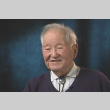
vh
Roy H. Matsumoto Interview Segment 43 (ddr-densho-1000-153-43)
Jobs in camp
Although Mr. Matsumoto does not identify himself as a Kibei (American-born person of Japanese ancestry sent to Japan for formal education and socialization when young and later returned to the U.S.), some of his life experiences are similar to those who do identify themselves as such.

Narrator Susumu Iwasaki
Nisei male. Born June 18, 1927, in Terminal Island, California. Grew up in Terminal Island before being removed to the Manzanar concentration camp, California, during World War II. Joined the Military Intelligence Service, working as an interpreter in Japan during the U.S. occupation. Married in Japan and eventually returned to California.

Narrator Rose Ito Tsunekawa
Nisei female. Born July 9, 1930, in Salinas, California. Grew up in Salinas, where father ran a successful farm. In 1941, moved with family to Japan. Remained in Japan during World War II and worked as an interpreter. After the war, returned to the United States and presently lives in California.

Narrator Jimmie S. Matsuda
Nisei male. Born June 16, 1927, in Hood River, Oregon. Grew up in Hood River, where parents ran a farm. At the age of thirteen, went to Japan with family for a vacation and ended up staying there. Attended school in Japan and then was trained in the Japanese air force as a kamikaze pilot. Instead …

Narrator Richard E. Yamashiro
Nisei male. Born February 13, 1929, in Seattle, Washington. Grew up in Hollywood, California, and was living there when Japan bombed Pearl Harbor in 1941. Removed to the Manzanar concentration camp, California. Parents signed "no-no" on the so-called "loyalty questionnaire" and the family was transferred to the Tule Lake concentration camp, California, then designated as a …
